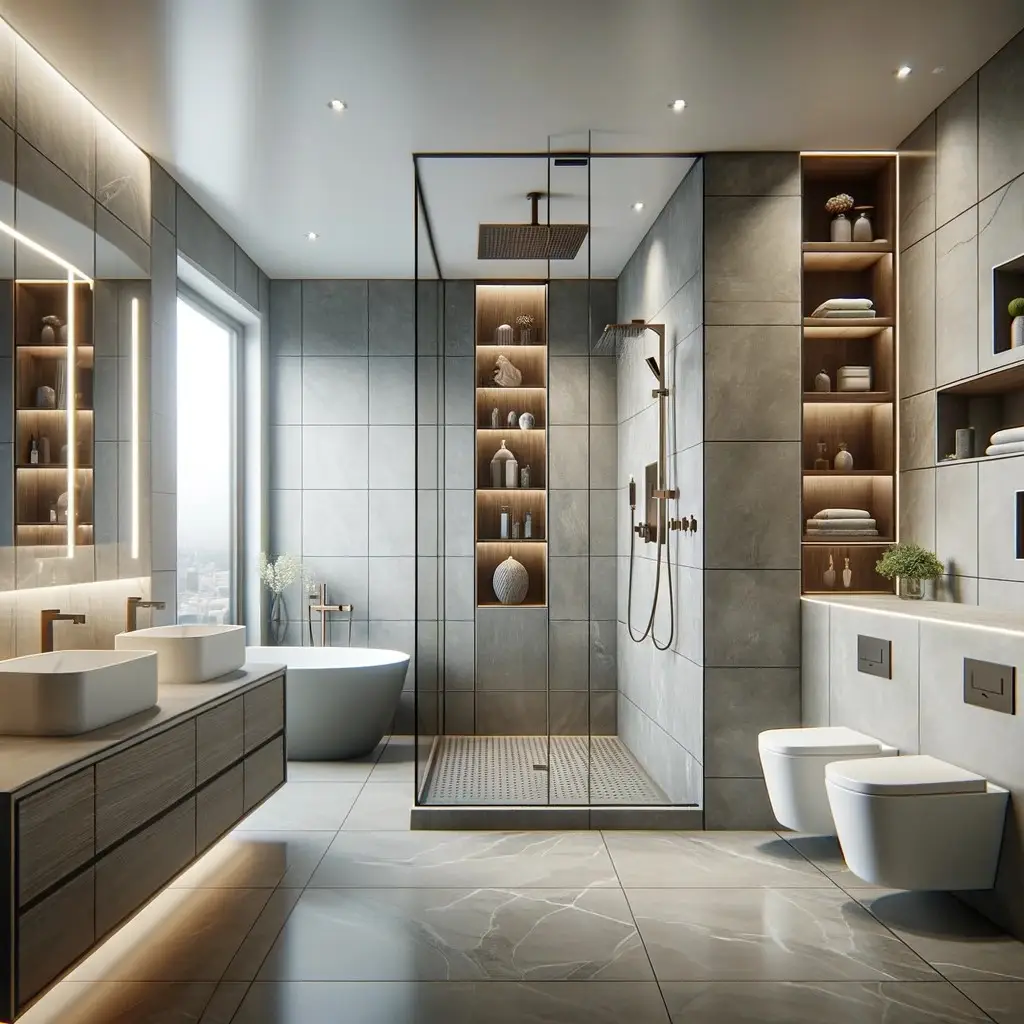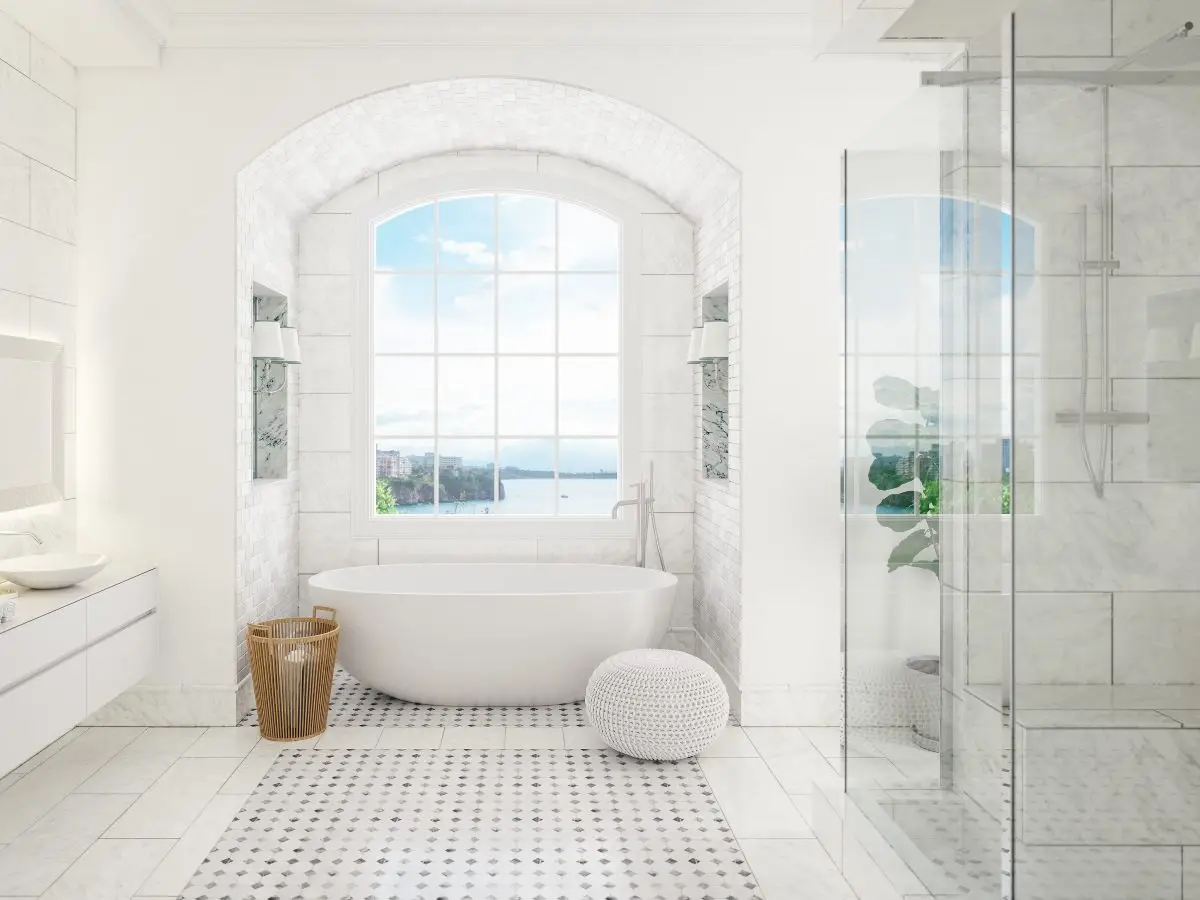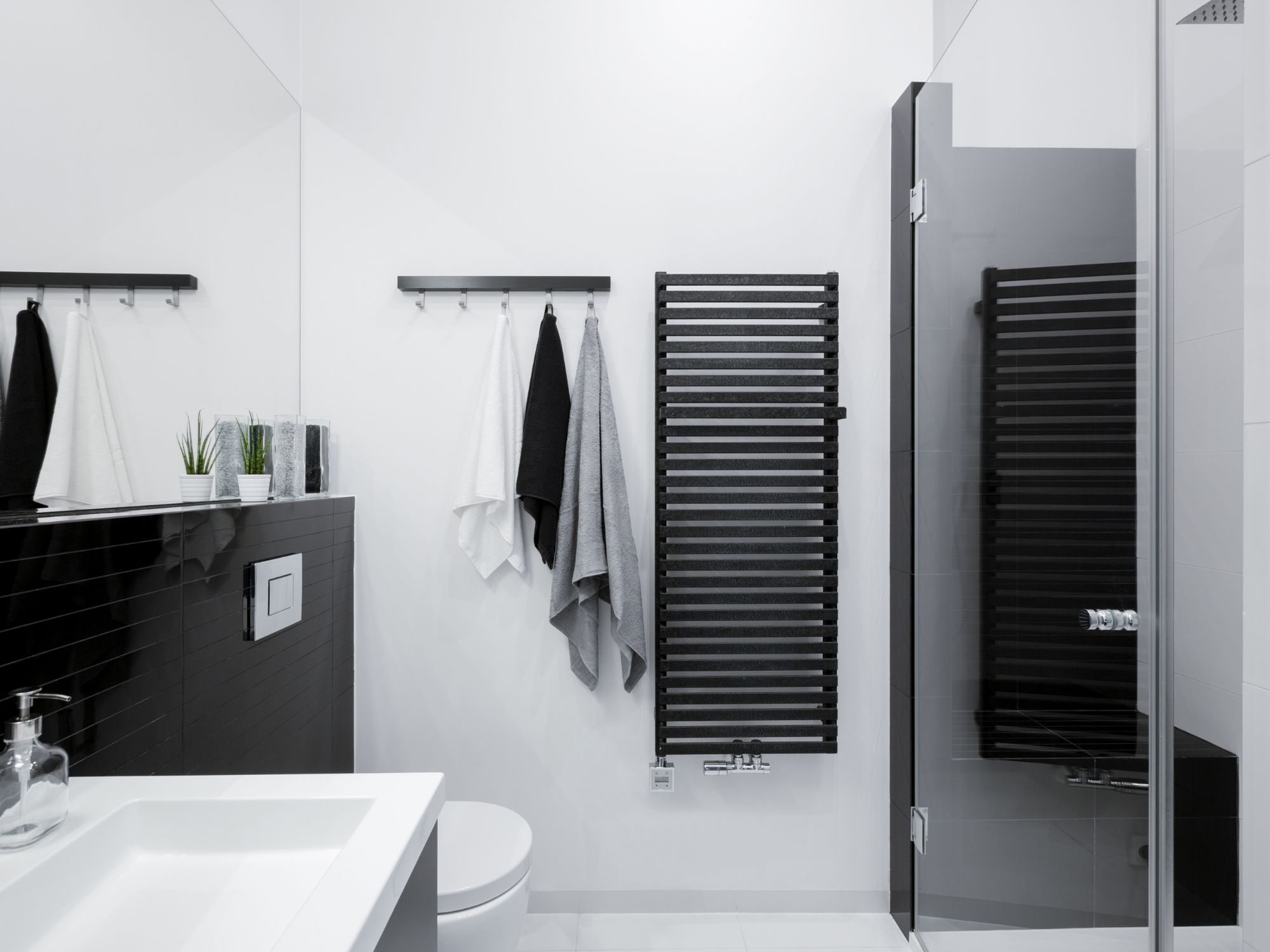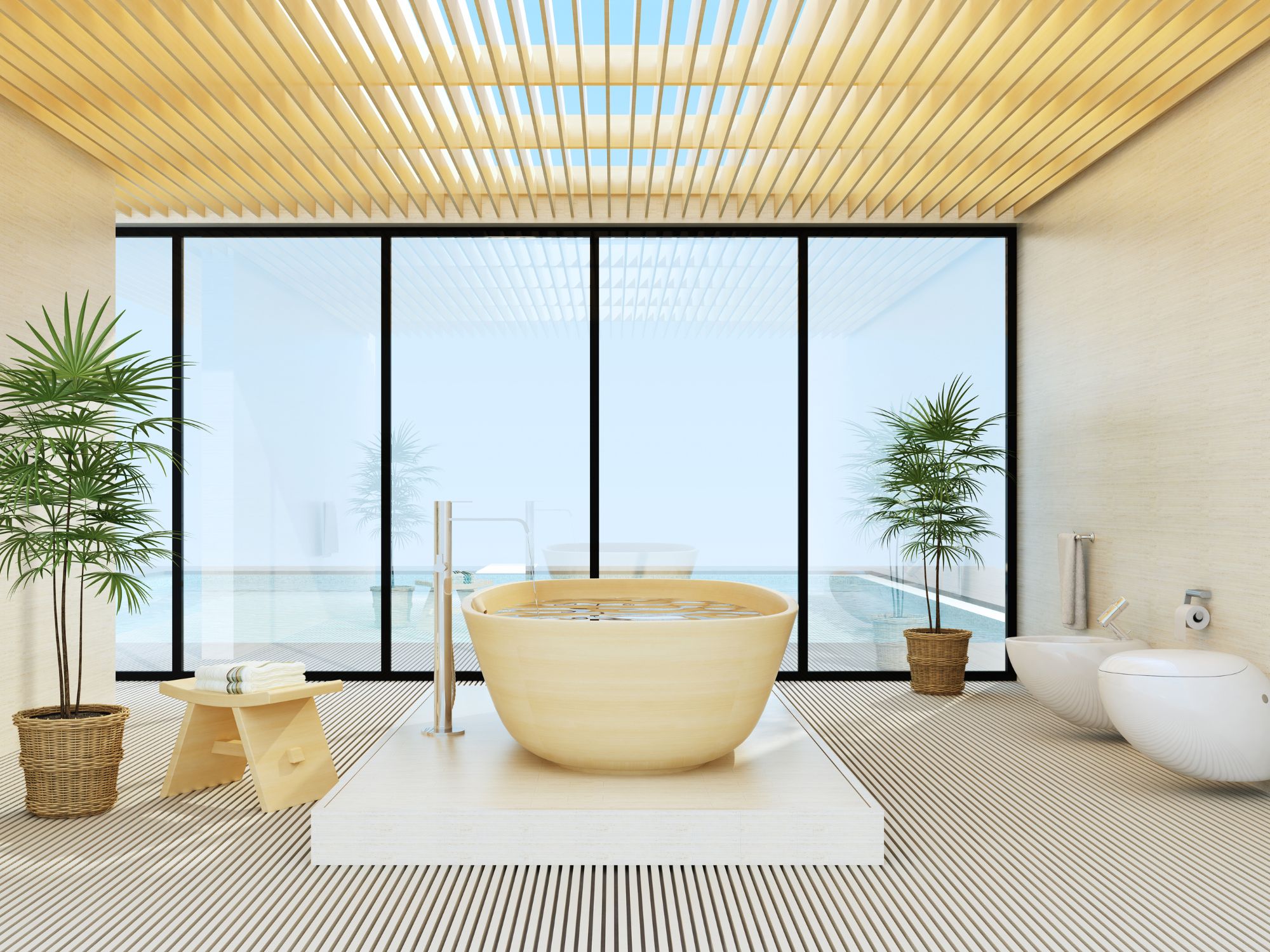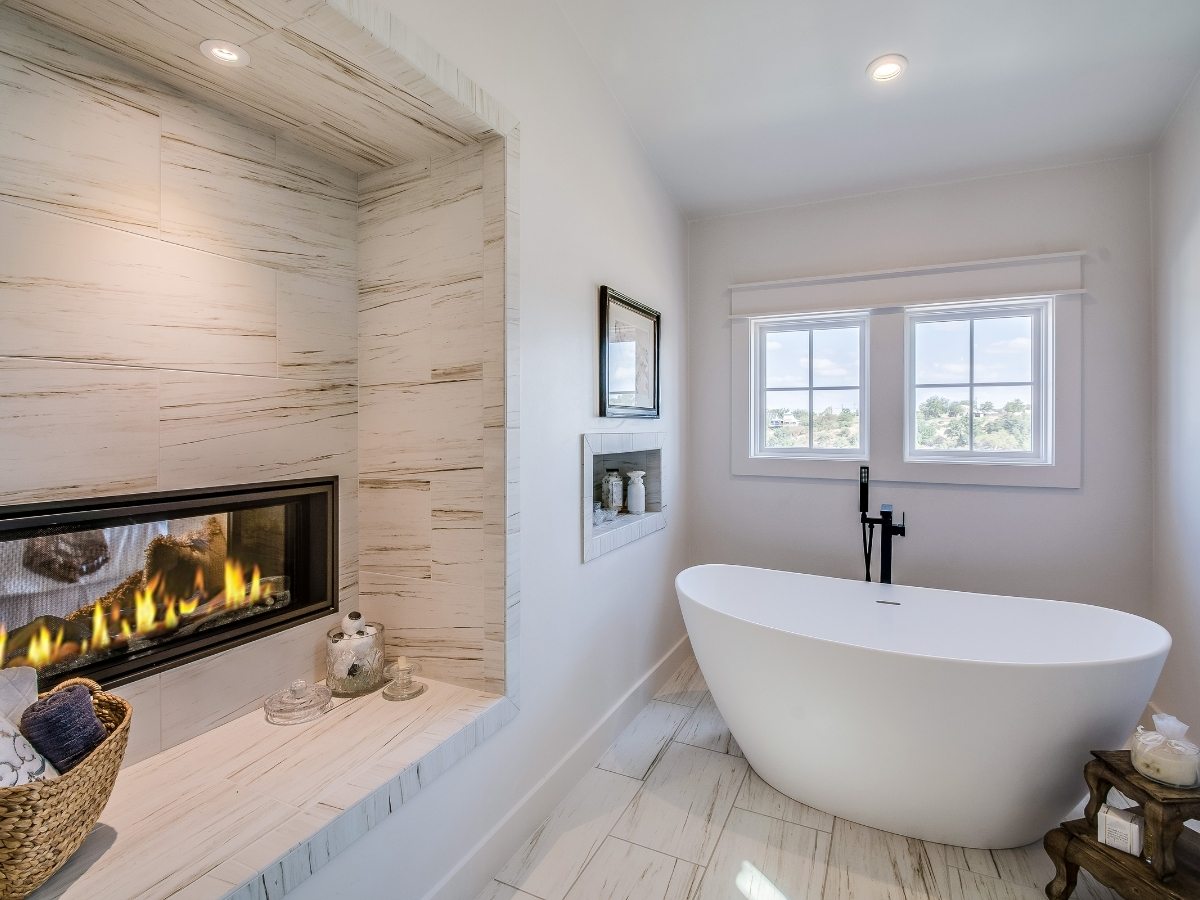This post may contain affiliate links which means I may receive a commission for purchases made through links at no cost to you. I only recommend products that I have personally used or curated specifically after reviewing and ensuring its quality! Learn more on my Private Policy page.
1. Home Value – Elevating Value Through Bathroom Remodeling
A full scale Home Remodeling transcends mere cosmetic upgrades; it embodies a calculated endeavor aimed at augmenting the intrinsic home value of a dwelling. Bathroom remodels harbors a transformative potential and can be the jewel of all Home Remodeling endeavors.
Industry experts widely recognize bathroom remodels as one of the most lucrative home improvement projects in terms of return on investment (ROI). According to various studies and surveys conducted by reputable sources such as the National Association of Realtors (NAR), and Zillow, a well-executed bathroom remodel can yield a significant increase in home value.
By scrutinizing the intersection of personal satisfaction and fiscal prudence, we aim to unravel key rules that help homeowners make remodel decisions underpinned by strategic investment understanding.
The value added by a remodeled bathroom can vary depending on several factors such as the scope, scale, and complexity of the remodel; the quality of materials and fixtures used; and the local real estate market conditions.
It’s important to note that the exact value added by a bathroom remodel can vary based on individual circumstances, but investing in upgrades that enhance both the functionality and aesthetics of the space can yield a significant return on investment in terms of increased home value.
Purpose of Article
This article is the second of a five part series. The goal of this article is to provide homeowners and others with insights into the factors that influence the amount of money to spend on a bathroom remodel and how to make decisions that hone in on these specific considerations. We think it would be beneficial to read this article in conjunction with our first article of the series on how to compile – Bathroom Remodel Cost: Essential 2024 Guide To Budgeting Smart.
In the third article we explored strategies on how Bathroom Remodeling Enhances Investment Property Values.
The forth article provide some guidance in making remodel decisions relative to selecting Bathroom Remodel features that favors Enjoyment Value verses those that favor Return on Investment (ROI) so as to foster decisions that promotes financial recoverability. In the fifth and final article we will review frequently asked questions and other key issues.
The approach outlined herein is equally applicable, with the necessary adjustments, or course, to all types of home remodeling projects not just to bathrooms.
Some of the information and approaches discussed would seem challenging to grasp at times but we really ask for your patience as understanding them will help you make better investment decisions in your next remodel project.
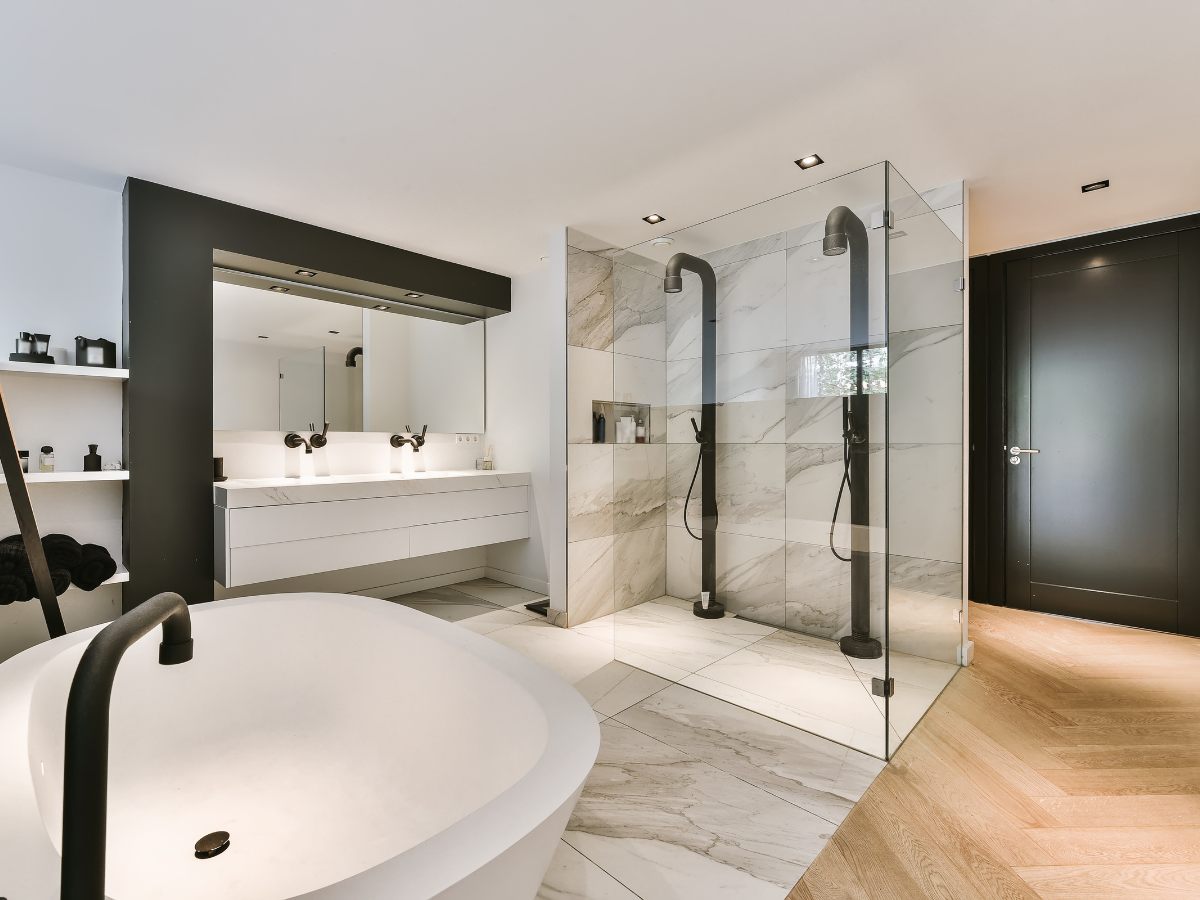
2. home remodeling basics – Terminology 101
On average a well-executed bathroom remodel can increase the value of a home anywhere from 10% to 20% while a bathroom remodel recoups around 60% to 70% of the expended cost of the remodel. This is the reported data within the bathroom remodel niche.
We will use this observation to build a model that shows and explains how to make decisions relative to bathroom remodeling. The model does not need the data perse but the data is useful to illustrate the foregoing.
Before we begin we need to explain a few concepts and terminology as this will assist with the analysis, so bear with us!
Value Added by the Remodel
In theory the remodel adds a value equivalent to the Return on Investment (ROI) to the Market Home Value. At a given ROI, the Home Market Increment Value would increase the home’s market value. An ROI of 20% adds a value equivalent to 20% of the home’s market value. In general, the magnitude of the ROI may reflect the scale or market alignment of the remodel.
A larger ROI may indicate a more extensive or high-end remodel that significantly enhances the property’s appeal compared to an ROI of 10%, which may focus more on cosmetics, but not necessarily.
Financial Gap/Loss
The difference between the “Bathroom Remodel Cost” and “Home Market Increment Value” represents the financial gap (negative or positive). The amount spent on the remodel that exceeds the Home Market Increment Value would lead to negative “Gap” and vice versa. As we will demonstrate shortly below, scenarios with higher recoup rates lead to a smaller financial gap. From a financial investment perspective the goal should be to have a positive or less negative “Financial Gap” .
Enjoyment Value
Considering the financial gap as an “Enjoyment Value,” is understanding that the remodel represent an intangible benefit to the homeowner. A larger negative gap might be justified by personal enjoyment, lifestyle enhancement, or specific non financial needs met by the remodel. This explains why in many cases remodel cost far exceeds Home Market Increment Values i.e. the increase in the value of the home due to the remodel.
Remodel Cost and Recoup Rate
Recoup Rates indicate the percentage of the Bathroom Remodel Cost (BRC) recouped in the Home Market Value, regardless of the remodel’s total cost. The gap between the Bathroom Remodel Cost and the Home Market Increment Value represents a financial loss which may not be directly recoverable through the home value increase.
A higher recoup rate may suggest a more efficient investment, recouping a larger portion of the remodel costs as part of the Home Market Increment Value. This rate might be achievable with strategic remodeling choices that align closely with market demands or through cost-effective remodeling practices.
The percentage loss is deem to be the result or the net effect of non-economic, economic, and financial factors. We briefly explain these below.
3. home remodeling – factors influencing Recoup Rates
Home improvements, such as bathroom remodels, immediately depreciate upon completion. The wear over time and shifts in style trends decrease the value that these upgrades add to a home. This devaluation, along with the subjective nature of home improvement’s worth, means that one person’s prized feature may not hold value to another. This challenges the assumption that improvements will directly increase home market value.
Real estate market trends further complicate this situation, as trends during the remodel may no longer be in vogue by the time the home sells, potentially diminishing the added value.
The financial outlay for remodels covers materials and labor, with the latter not contributing to resale value, potentially leading to losses when selling the property. Over-customization can deter buyers, limiting the pool and impacting the overall value. Additionally, money spent on remodeling bears an opportunity cost, where alternative investments might have yielded greater returns.
If you finance the remodeling, interest payments will increase the total expenditure, making recouping the investment even harder. Consequently, most home improvements do not fully return their cost at sale, with recoup rates typically less than 100%, highlighting the importance for homeowners to strike a strategic balance between personal satisfaction (i.e. Enjoyment Value) and financial investment.
A recoup rate of less than %100 reflects these realities and is an important consideration for homeowners to ensure they make financially sound decisions regarding home improvements. It underscores the need to be careful when remodeling and in making decision for personal enjoyment and use, versus for economic recoverability.

4. home remodeling – Initial observations
Observation 1: A quick rule of thumb can then be derived by multiplying the ROI by the current home market value i.e. (Home Market Increment Value) and comparing that to the result of the Recoup Rate multiplied by the Bathroom Remodel Cost which gives the Recoup Value.
If the Home Market Increment Value is greater than the Recouped Value, then the remodel may be a worthwhile endeavor depending on the conditions and preferences of the local market. But there are other things to consider such as time, enjoyment value, financial viability, and investment behaviors of owners or investors, which we will explore in this article!
Observation 2: The difference between the Home Market Increment Value and the Recouped Value can be deemed "Enjoyment Value" or from an economic perspective as a "Surplus/Financial Gap/Loss". A negative financial gap may not necessarily be a bad thing, like many decisions in life it depends on the anticipated use of the property over time! We will also discuss this in greater detail.
5. Bathroom Remodel scenarios – investment property vs residence
The above observations are interesting but are still too vague and does not provide a better understand of the “how much” question relative to determining the scale of investments one should make.
Consider two scenarios: first, investing in a property for short-term turnover without the owner’s enjoyment, and second, remodeling a home residence for the owner to enjoy over many years.
The question then arises: Whether we should approach these two scenarios differently?
The answer is absolutely, yes. They should be approached differently.
However, in this article we are concerned only with the case of a primary residence. We explored the second scenario in our article titled – Bathroom Remodeling For Enhanced Property Value: A Strategic Review.
home remodeling – Enjoyment Value, Financial Gap/Loss/Surplus
If we look closer at the above observations they reveal that the actual Cost of a Bathroom Remodel is usually greater than the Home Market Increment Value due to the Recoup Rate being less than 100%. Therefore, we can view the difference between the Home Market Increment Value (HMIV) and the Bathroom Remodel Cost (BRC) as an “Enjoyment Value,” especially when there is a negative Financial Gap or Loss.
This is not a precise interpretation of the “Gap” but doing so does help provide some clarity.
We can now adjust and loosely redefine the “Enjoyment Value” as the budget amount the homeowner is prepared to spend on a bathroom remodel even if that amount is greater than the future increase in the Home Market Increment Value.
Only the Recoup Value of the amount invested is recoverable through market value appreciation within a defined time horizon.
This recoverable amount is not usually economically feasible over the short term. In other words, if the home owner overspends on the remodel project the resulting market increment may not be recoverable until a time period has passed. If the home owner chooses to sell prior to that elapsed period they would realize a financial loss on the remodel investment.
home remodeling Working Model
To set the stage for our analysis we will need to set up a working model such that the value added to the home from the remodel less the cost of the remodel is equal to the net economic benefit i.e. a financial loss or financial gain.
The Equation is noted below: If Mathematics is not your thing just skip to “Understanding the Model“
Left side of Equation is the Home Market Increment Value (HMIV): [Home Market Increment Rate (HMIR or ROI) x Home Market Value (HMV)]
Right side of Equation is the Recoup Value (RV): [Bathroom Remodel Cost (BRC) x Recoup Rate (RR)]
Left Side Minus the Right Side: Surplus (Financial Gap/Loss/Gain).
With a bit of manipulation we can express the above as follows:
1. ROI = [RR + %Net Surplus] x %BRC. The ROI is assumed to be a gross value before all categories of deductions and expenses.
2. % Net Surplus = Surplus / BRC
3. %BRC = Bathroom Remodel Cost (BRC) / Home Market Value
4. RR(e) = [RR + %Net Surplus]
5. ROI = RR(e) x % BRC
Equation 5 is the final form of the Working Model
Therefore, the ROI is a product of the % investment expressed as a fraction of home value (%BRC) and an equivalent Recoup Rate, RR(e).
Understanding The Model
At a given ROI, Recoup Rate, BRC and HMV the left and right sides becomes equal to each other and the Surplus (Financial Gap/Loss) = 0. At that point the maximum Cost of the Remodel can be determined prior to experiencing a Economic/Financial Loss. Continuing to increase the cost of the remodel beyond this point will result in a negative Surplus.
Note that the Bathroom Remodel Cost (BRC) is the only factor the homeowner can directly influence; the market fixes everything else once owners make remodeling decisions. The homeowner indirectly influences the other factors through their decisions. Since the market fixes the left side (Home Market Increment Value), the relation is negative or positive, depending on the Bathroom Remodel Cost (BRC) and the Recoup Rate.
Non-investment properties undertaking a remodel would likely have a negative net outcome due to home owners propensity for remodel additions with inflated Enjoyment Values leading to negative Surpluses.
From our model above we are able to determine the value of BRC for a given value of HMIV, RR and ROI, assuming a surplus of “0”.
This would be the working model we assume in this article.
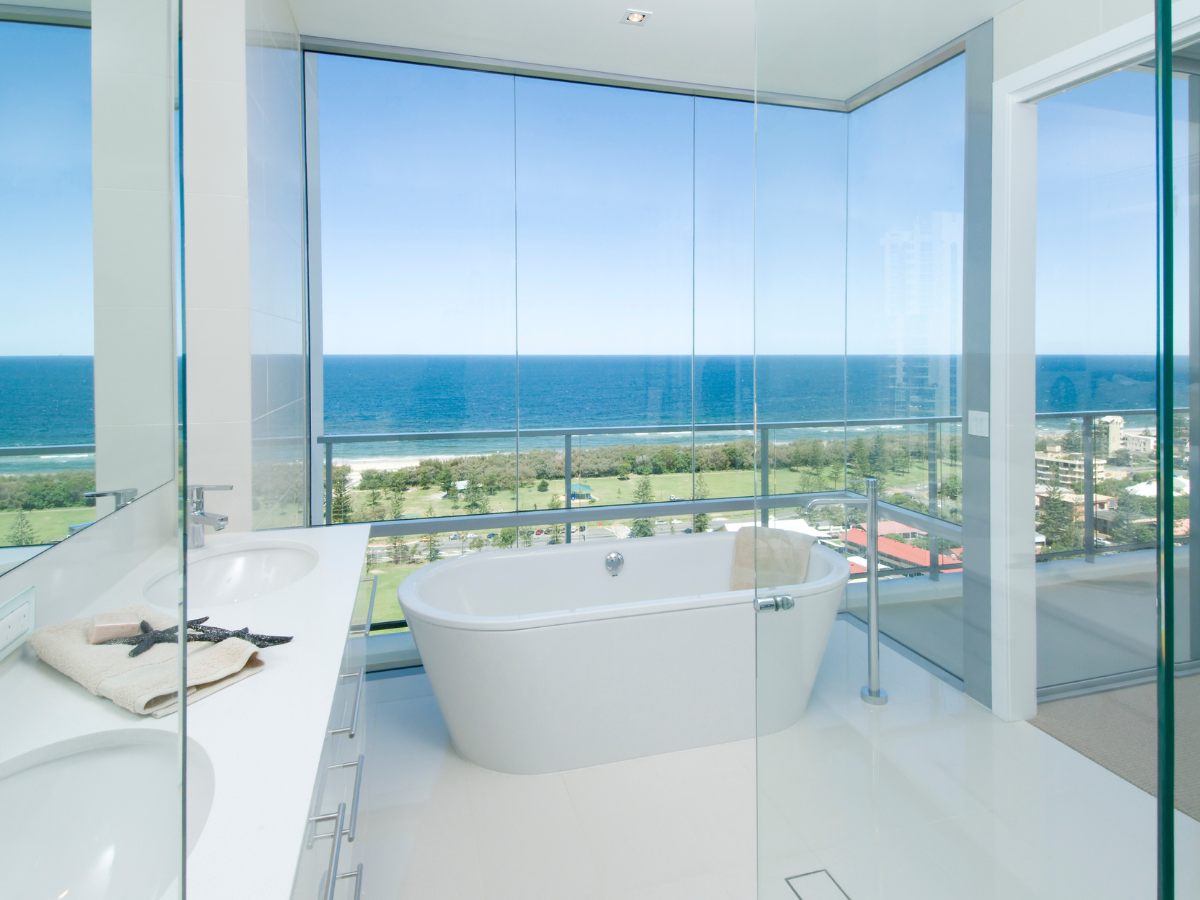
6. home remodeling – Basic analysis 101
Using the above Model we are able to produce some Graphics from which we will produce some key insights. Graphic No. 1 below illustrates the cost-benefit analysis of undertaking a bathroom remodel based on a given home market value. It compares the value added by the remodel to the actual remodel cost at an average equivalent Recoup Rate of 60%.
The label “60% of Remodel Cost” on the dash line represents the full actual Bathroom Remodeled Cost, i.e., the cumulative amount you paid the contractor and all those involved in providing services and materials to perform the remodel work within a market with an RR of 60%.
The solid green line indicates the increase in Home Market Value due to the remodel i.e. the left side of the relation given above – in this case we used an ROI of 10%. For example, for a home with an initial Market value of $0.6M, the home market increment value (HMIV) would be $60,000 once the remodel is completed, but the cost of the remodel would be $100,000, $40,000 of which can be loosely considered the “Enjoyment Value” and other factors are deemed a Financial Loss from an economic analysis perspective! given the low value of RR at 60%.
This financial loss is time dependent as we shall discuss below.
The green shaded area partially indicates the “Enjoyment Value” i.e. the additional qualitative benefit the homeowner gains from the remodel while continuing to live in the home or the financial loss experienced should you decide to sell without recouping the initial remodel investment, especially the spent amounts greater than the HMIV.
Amongst other things, it represents the intangible benefits of the remodel to the homeowner.
Intangible Benefits vs Financial Feasibility
In theory the entire area beneath the BRC Curve (i.e. 60% of Remodel Cost), even the portion below the solid green line, is considered “Enjoyment Value” but only the enjoyment value below the solid green line HMIV Curve is economically supported or recoverable. The portion above it is attributable to market inefficiencies, sunk or opportunity cost, etc. (i.e. RR<100%) and the home owner’s emotive behavioral choices.
We shall explore this further below also.
Observation 3 - The enjoyment value increases with increasing Bathroom Remodel Cost, lower RR, larger remodel investments, and for homes with larger market values for a given market and ROI. The assumption here is that the features added in the remodel add to the enjoyment of the space.
Graphic No. 1

7. Influence of recoup rates on remodel costs – roi of 10 %
In Graphic 2 below, we added a curve for the 70% Recoup Rate case to the above analysis. The area between the two Remodel Cost Curves RR 60% and 70% represent the “Financial Gap or the net financial loss or the financial disadvantage of proceeding with a remodel project under a 60% Recoup Rate versus a remodel with a Recoup Rate (RR) of 70%.
The question is why would a home owner do anything to decrease the Recoup Rate from 70 to 60% given the fact that it is financially disadvantageous? The truth is that home owners do this exact thing everyday by overspending on features of the remodel which are not financially recoverable on resale.
For any given home market value the “Financial Gap”, i.e. the space between the RR 60 and the RR 70 curves, effectively illustrates how much more is being lost performing a remodel with a Recoup Rate of 60% than at a RR 70% which emphasizes the financial inefficiency or reduce return value on the investment.
Continuing with the example from above – a home with a market value of $0.6M will fetch a Home Increment Value of $60,000 (Blue line where RR=100%) but if the remodel had an initial expected RR of 70% but only a RR of 60% was gain, then a financial loss of about $10,000 would result i.e. ($100,000 Red line – $90,000 green line).
Observation 4 - This highlights the importance of carefully evaluating the interplay between the expected Remodel Costs of the anticipated remodel against the potential impacts to Home Market Increment Value, Recoup Rates, and the Enjoyment Value. In other words, it is important to understand what remodel decisions or choices will affect the RR rates and ROI rates and counter them early during remodel planning.
We will return to this issue below to provide some guidance.
Graphic No. 2
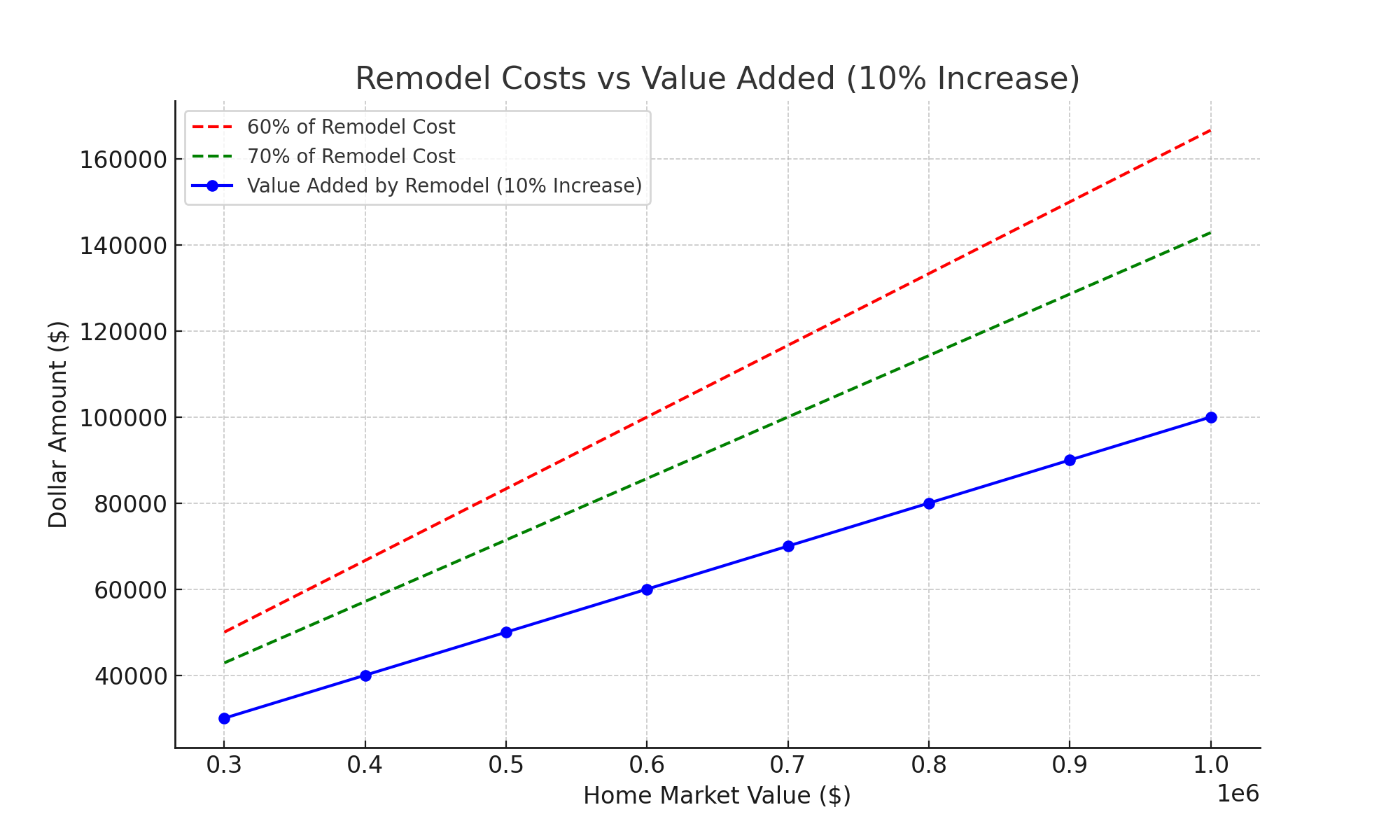
8. Influence of recoup rates on BRC and HMIV – roi of 20 %
Below is a similar graphic as that above except considering a Home Increment Market Rate or (ROI) of 20%. Continuing with the example from above – a home with a market value of $0.6M will fetch a Home Increment Value of $120,000 compared to $60,000 from the previous case at 10%, a net gain of $60,000.
If the expected recoup rate was 70% but only 60% was realized then an immediate financial loss of about $20,000 would result i.e. ($200,000 Red line – $180,000 green line). The revised remodel cost is now $200,000 compared to $100,000 at an ROI of 10%. But the BRC may not change if the project is already done or is in progress.
If that is the case, for the same remodel cost as noted in the Graphic 2 above a change to a 20% ROI market would yield to a doubling of the HIMV and a net positive surplus / financial gain of $60,000 – $20,000 = $40,000 compared to the previous case, in spite of the reduction in RR from 70% to 60%.
Note that in this case the only thing that has changed is the ROI. Although there was a precipitous loss to the home owner due to unrealized Recoup Rates – there was a net positive surplus due to the increase HMIV.
Whilst the home continues to be inhabited the loss due to the RR change does not adversely affect Home Valuation but is realized only when the home is disposed of or valuated for re-financing purposes.
So timing is a key factor in realizing a loss or gain in home value after performing a remodel.
Observation 5 - Decreasing Recoup Rates have an adverse impact on Bathroom Remodel Cost. Upward movements in the ROI will potentially lead to a net positive financial gain and vice verse for the same Remodel Cost depending on the relative interplay between ROI rates and RR. It is important to note that a greater immediate financial loss is realized if the property is disposed of soon after the remodel is completed compared to if the home is enjoyed for several years after. If the home continues to be inhabited then the Enjoyment Value or financial loss can be converted to a financial benefit through long-term capitalization of the benefit. However, this is a risk that needs to be mitigated especially in an inflating economy and/or under inflated remodeled cost.
Graphic No. 3
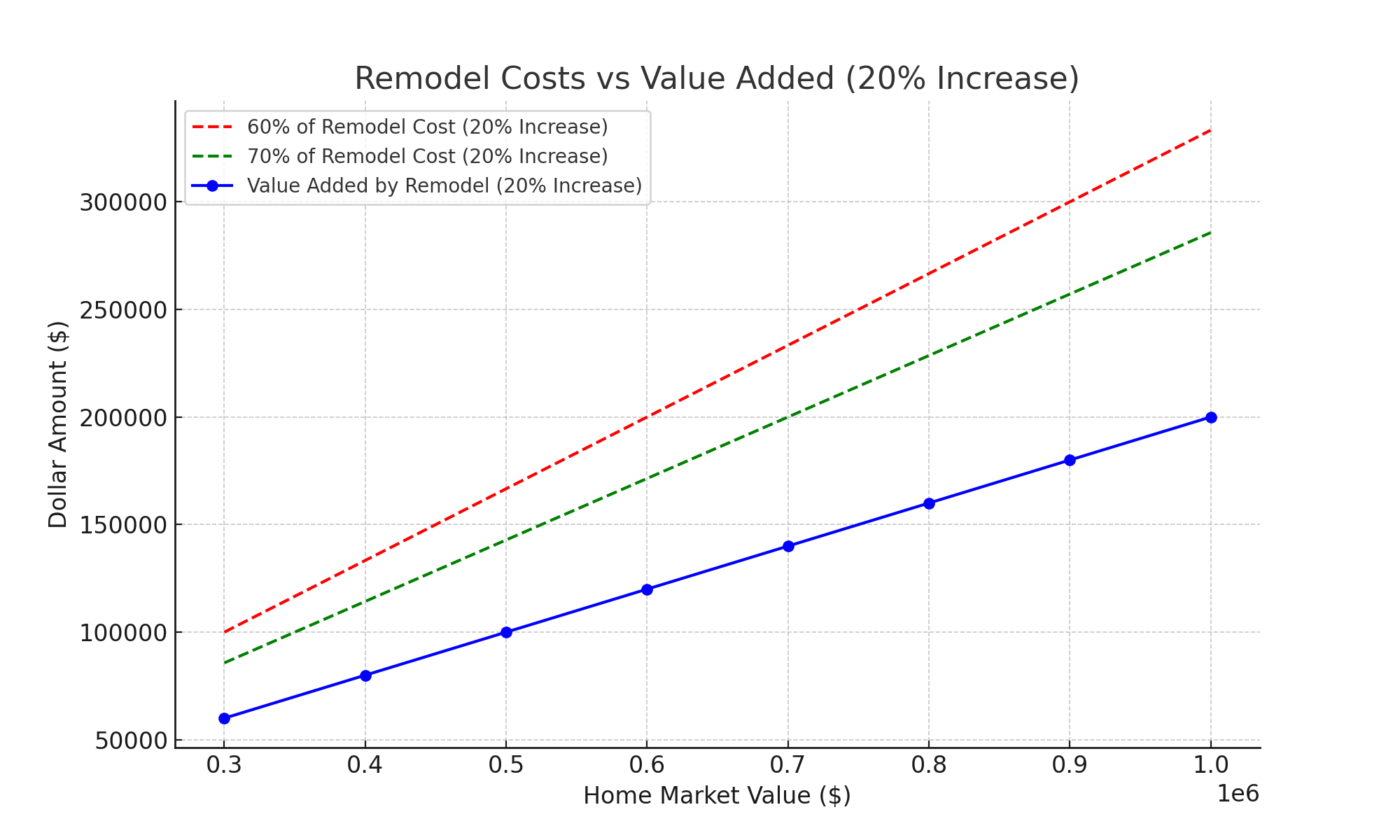
9. Recoup rates, ROI and Investment Efficiency
For a given remodel investment compared under two ROI scenarios, say10% and 20%, the scenario with a 20% ROI generally shows a closer alignment between the remodel costs (red or green lines) curve and the Home Market (blue line). This is because the cost of the remodel would be the same under both scenarios. The higher recoup rates would cause the effective recouped value to increase and the related remodel cost curve would move downwards closer to the Home Increment Value Curve (blue line where RR =100%).
In other words as the Recoup Rates approach “100%” the Remodel Cost Curve and the Home Increment Value Curve move closer together which is economically desirable. This may seem to suggest that more ambitious remodeling projects that significantly boost home value might also come closer to breaking even (Surplus = “0”) or even yielding a net positive financial return when executed efficiently.
However, caution is required before a definitive answer can be provided to this statement. The required analysis to provide clarity to this statement is beyond our current scope.
Observation 6 - Common sense dictates that a 20% ROI offers a higher Surplus Value between an investment (Remodel Cost) and the return (Home Market Increment Value) the higher the recoup rate. This observation underscores the importance of careful planning remodel decisions and choices related to: 1. The scale and complexity of the remodel 2. The need to perform market research within your local area 3. Ensuring adequate cost control and scope management is planned for 4. Risk mitigation and project managing of the Contractor These will go a long way in maximizing the financial viability of the remodeling project and curtail escalating remodel cost which can consume/absorb market returns and drive RR and ROI lower!
10. home remodeling – Simplifying the Results and analysis
So far we have made observations and explained in some detail why it is important to be careful and to consider many factors in making remodeling decisions relative to determining your bathroom remodel budget. What we have not discuss is how does a home owner navigate these issues with relative ease without undertaking an untenable level of analysis and research.
To demonstrate let’s review Graphic 4 below which displays three curves representing the relationship between the Home Market Increment Rates or ROI (10%, 15%, 20%) and the Bathroom Remodel Cost expressed as a “%” of the Home Market Value for three different Recoup Rates, 60%, 65%, and 70%. Each curve is labeled according to its respective recoup rate.
The Graphic is essentially the same as those given above but reformulated for ease of use and analysis.
Taking A Closer Look
Graphic No. 4 is such that the “X” axis captures the “% Bathroom Remodel Cost” and the “Y” axis captures the Home Market Increment Rate % or the (ROI). As noted above the “% Bathroom Remodel Cost” is defined as the “Bathroom Remodel Cost” expressed as a percentage of the Home Market Value.
We can now use this chart to get a ballpark understanding as to how much to spend on a bathroom remodel based on three key data points from your local real estate market conditions. First, the Home Market Increment Rate or ROI. Secondly, the Recoup Rate within your local area, and thirdly your Home Market Value. These data points can be obtain from Real Estate professionals or agencies in your area who would usually provide valuations for free based on comparative sales in your area.
Knowing the ROI (enter via the Y-axis) and moving horizontally intersect the appropriate Recoup Rate curve, then move downwards to the X-axis to find the “%Bathroom Remodel Cost”. Your goal should be to minimized this value i.e. “%Bathroom Remodel Cost”. We will discuss how to do this below.
But before we explore how to minimize the “%Bathroom Remodel Cost” we need to explore three more concepts, see the next sections.
Graphic No. 4
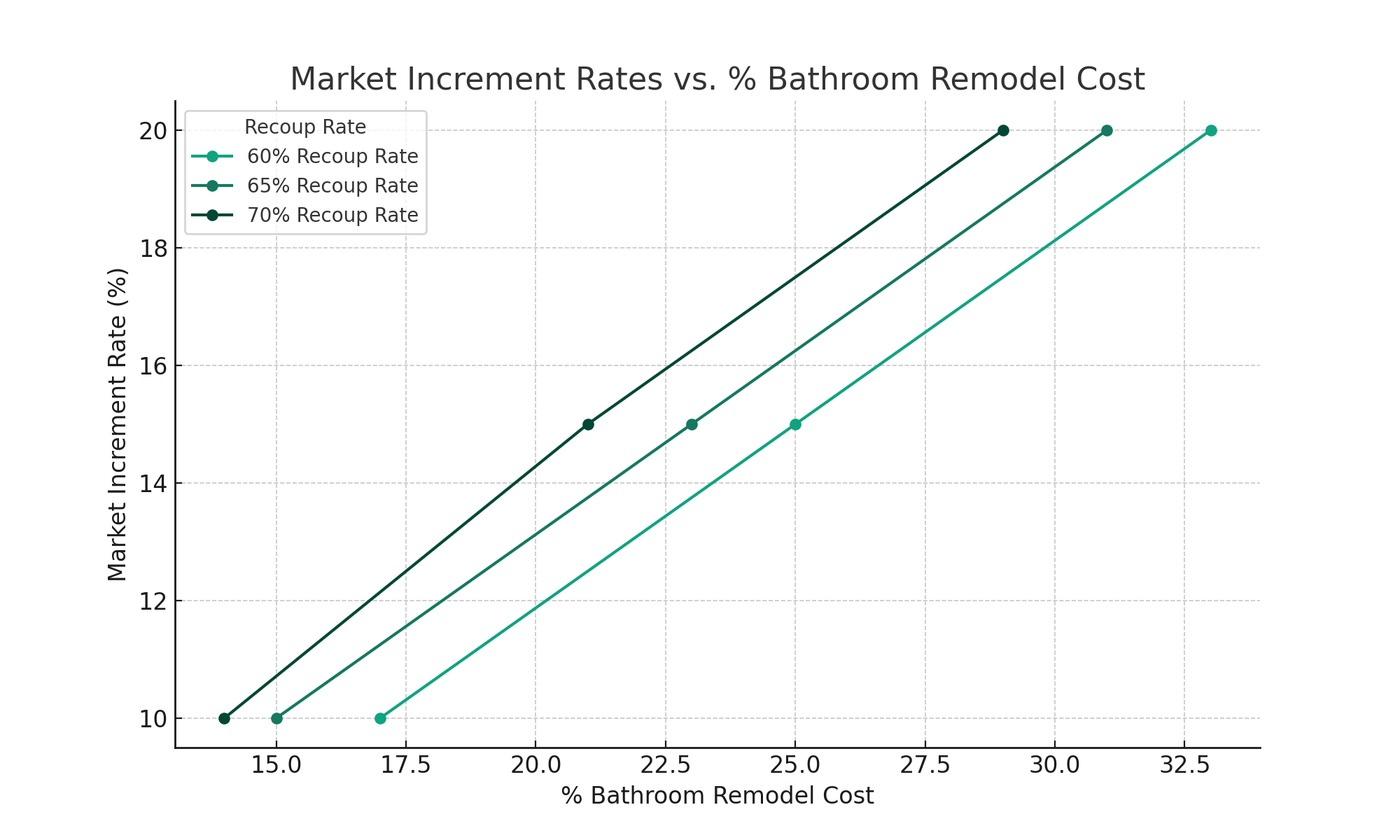
11. home remodeling – The Case For Economies of Scale
The earlier curves in Graphic 4 above showed a linear relationship between the “% Bathroom Remodel Cost” and the “Home Market Increment Rate”. However, the nature, scale, and complexity of the remodel project can influence modern construction costs behaviors through economies of scale opportunities.
To illustrate, we will make the simplified assumption that once the “% Bathroom Remodel Cost” reaches 20%, the remodel cost will begin to decrease by 10%. This adjustment will reflect the assumed economies of scale reductions achievable in the market based on the scale of the remodel, and it’s complexity relative to the size and value of the home.
This will engender cost efficiencies in performing the remodel such that the actual remodel cost and “%Bathroom Remodel Cost” will decrease.
The dash lines in Graphic No. 5 are the result of the economies of scale applied to the curves shown in Graphic No. 4. The modeled simulation indicates lower %Bathroom Remodel Cost for the same Home Market Increment Rates and Recoup Rates.
You should not interpret the results as supporting larger remodel projects merely because the market offers cost reduction opportunities with scale. The decision should rely on the timing, justification for scaling up, the homeowners’ enjoyment needs, and the local market potential.
Our aim here is simply to show the behavior of the Remodel Cost Curves under cost reduction influences. Graphic No. 5 will be the Graphical form of the working Model we will use to put all the pieces together and provide the homeowner a way forward out of the maze.
Complexity
As we introduce various economies of scale considerations, the Cost curves will cease to be linear functions and will become more complex to analyze. Likewise, although we have introduced only three RR levels, one can imagine a denser spacing with closer intervals of RR considered.
Let’s touch on two more concepts before we revisit and finish our thoughts.
Graphic No. 5
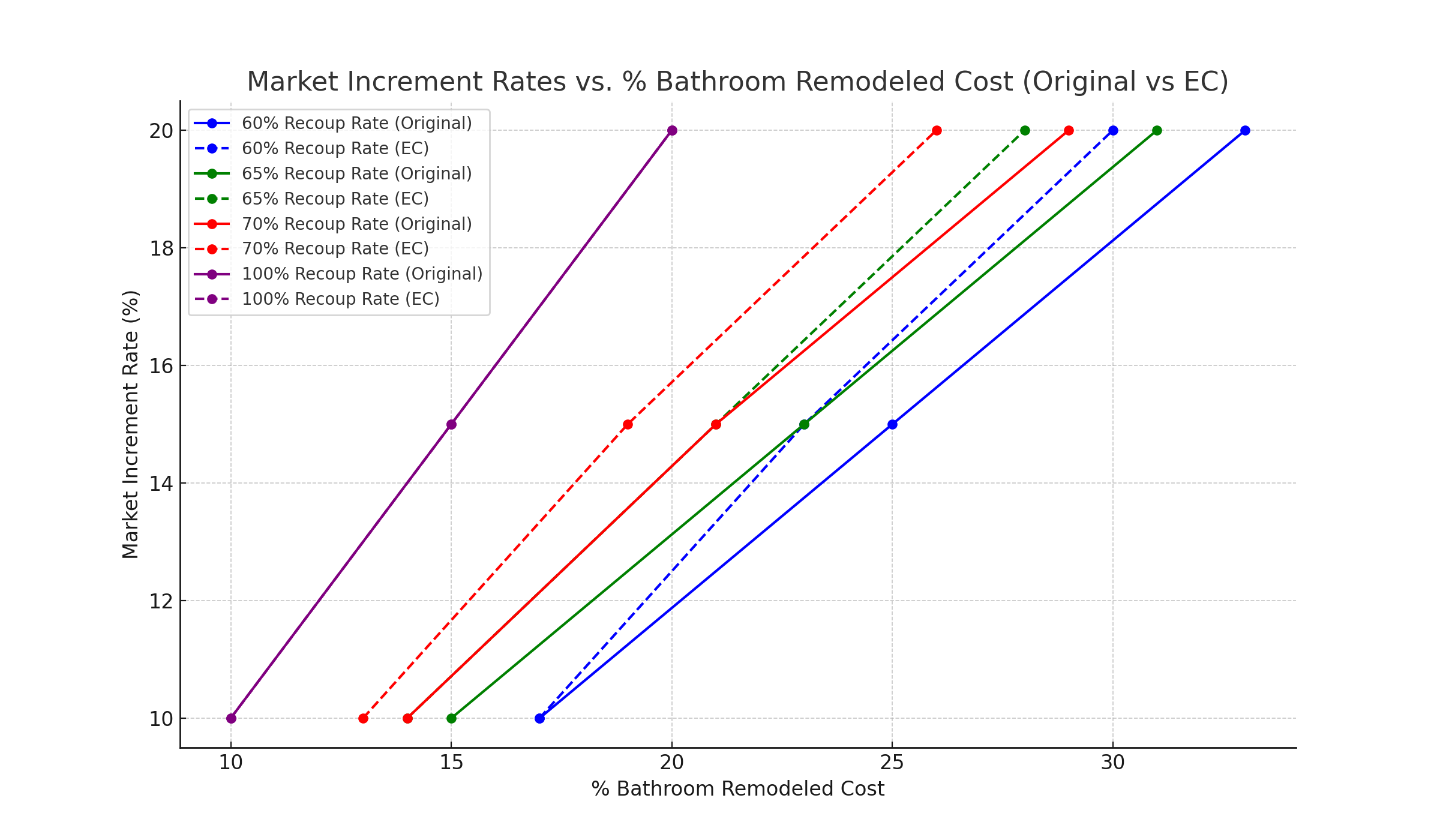
12. home remodeling – Impact of timing on enjoyment value
The concept of “enjoyment value” quantifies the intangible benefits that a homeowner derives from a bathroom remodel, which the financial metrics of the home’s market value may not directly reflect. Time plays a crucial role in how a remodeling project investment becomes a financial loss but deemed beneficial from an enjoyment value perspective. Let’s review how “Time” can influence a home owner’s decision related to the amount invested in bathroom remodel cost.
When contemplating a remodel, the amortization of costs over time is a key consideration for long-term residents. The enduring enjoyment and utility that a renovation provides can offset the initial expense, making the upfront costs more palatable as they spread over many years. Homeowners often form a strong emotional bond with their renovation plans, and elevate the value of the remodeled space beyond mere numbers.
The daily use of a remodeled area is associated with an enhanced lifestyle, overall satisfaction, potentially justifying the initial outlay.
Market fluctuations can also play a role; while immediate returns may not fully recoup the investment, market appreciation over time can lead to financial gains when selling the property. The home owner therefore, uses this future valuation and potential increase in ROI to sway their final decision regarding scale, size and scope of a renovation irrespective of its neutral or negative financial position.
In their view a well-designed bathroom with some “bells and whistles”, for instance, can offer psychological comfort that transcends cost considerations.
In summary the initial investment though not economically supported by the market can prove to be otherwise justified providing time allows the Enjoyment Value to be capitalized.
This is what we have termed as the “Remodel – Time Prison Dilemma”.
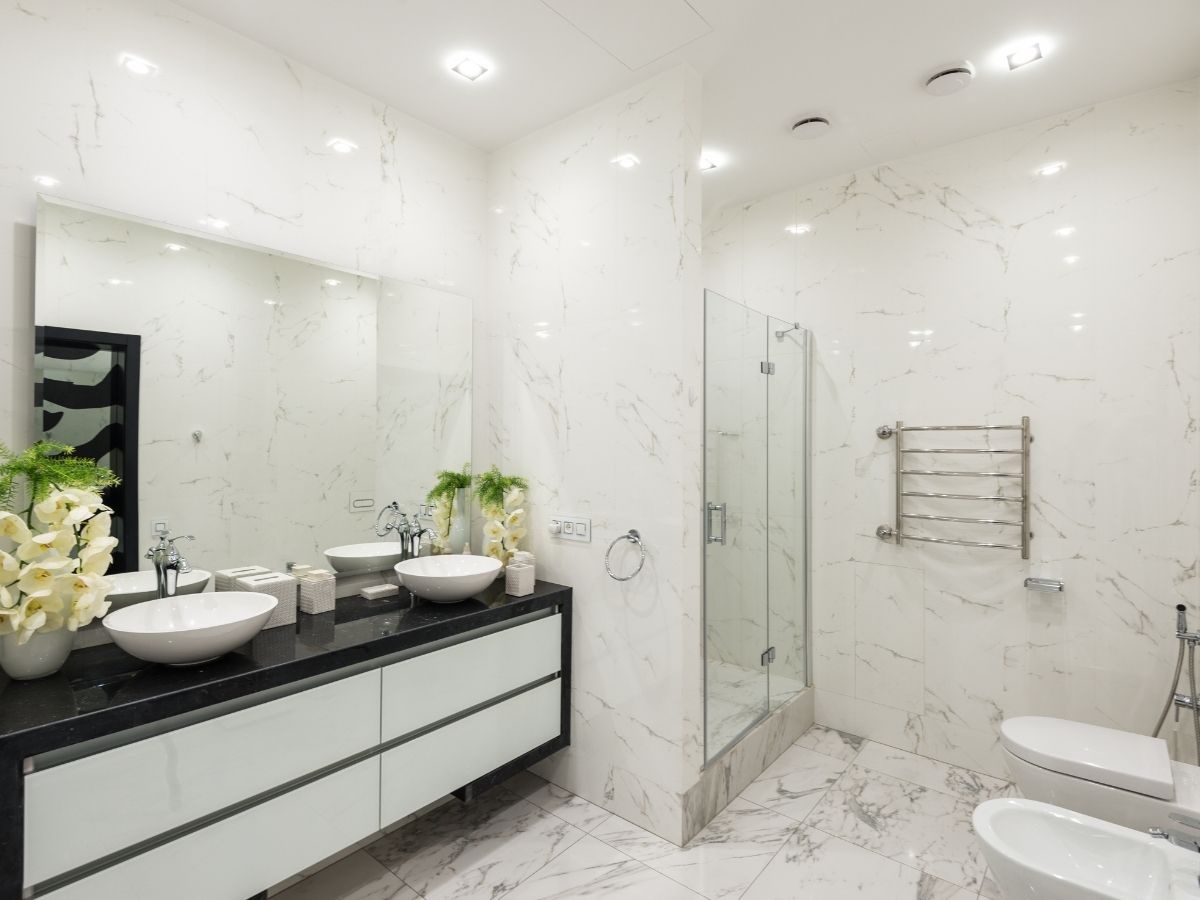
13. Impact of timing on investment and financial loss
Incurring bathroom remodel costs that exceeds the recoup rate is generally considered unwise from a purely financial investment standpoint for the following reasons:
Investing in a bathroom remodel at a recoup rate below the market’s average is financially imprudent if the plan is to sell the property in the short term. A short term ownership period won’t allow for adequate value appreciation. Rising remodel costs often yield diminishing returns, where additional spending doesn’t proportionately increase home value, leading to overcapitalization i.e. you invest too much in the remodel effort.
Markets without significant property value growth amplify this risk, making it unlikely that sales will recoup expensive, over-standard renovations. The opportunity cost of such investments is also high; allocating funds to an excessive remodel could have yielded higher returns if used for other improvements with better recoup prospects or different investments altogether.
Financial risks escalate with large remodels, particularly those financed through loans, as unforeseen circumstances may necessitate a sale at a loss. Furthermore, highly personalized renovations may not resonate with the broader market, reducing the likelihood of recovering the costs and reinforcing the importance of aligning remodels with broad appeal standards.
While the enjoyment and utility of a remodeled bathroom can contribute to a homeowner’s quality of life, from an investment perspective, it is essential to balance personal preferences with financial pragmatism.
The key is to ensure that all performed improvements align with housing market values and to avoid spending that significantly exceeds the expected return.
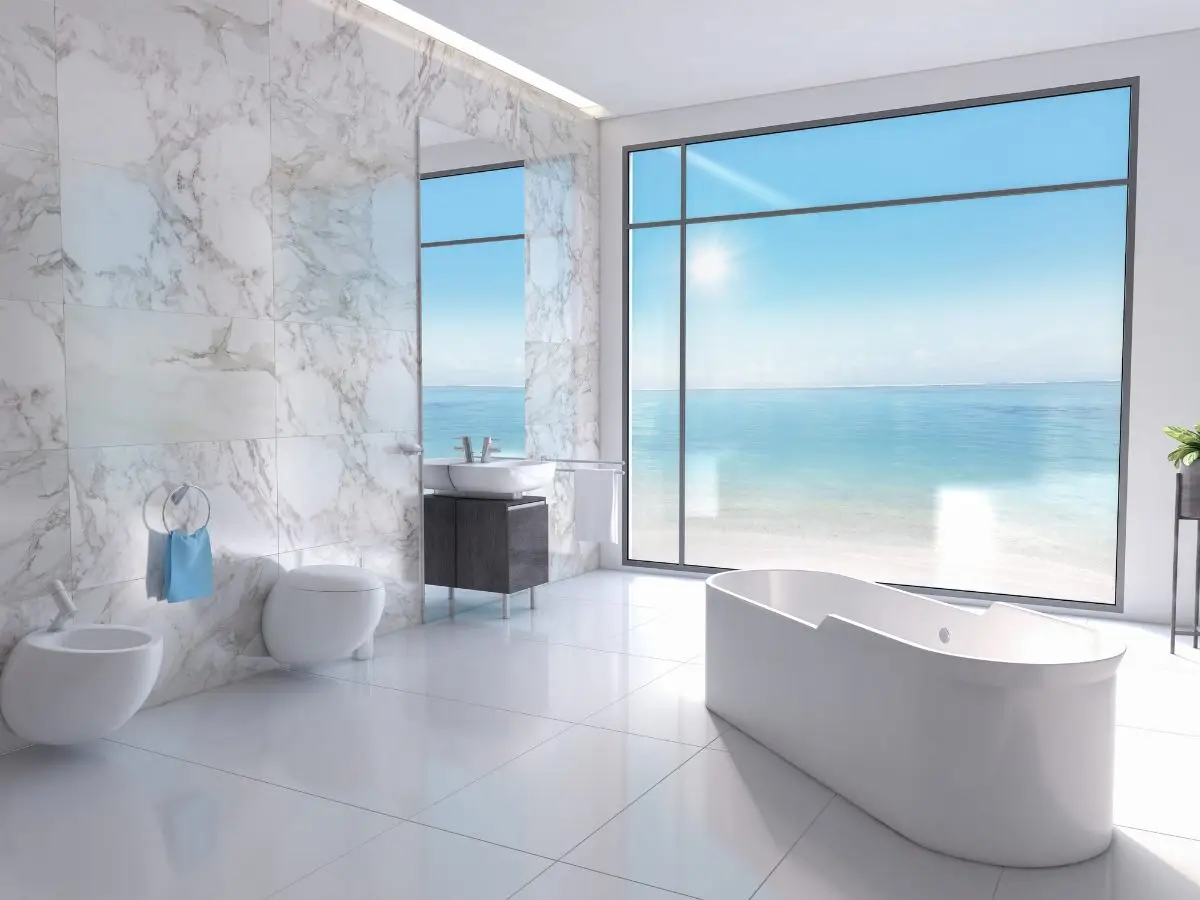
14. Lets tie it all together – Some Key observations
Having reviewed these last three concepts we are now able to provide a summary review or analysis so that a homeowner can understand how behaviors regarding scope, scale and cost of bathroom remodel projects impact their economic recoverability of the remodel investment.
We will then develop decision rules using the three critical data points (RR, ROI, HMV) to demonstrate how remodel choices can be made to be both personally satisfying and financially prudent.
But first, here is a summary analysis which encapsulates the economic and financial implications of a remodel project and how to navigate towards shallower less adverse financial waters:
Summary Analysis: So let's step back and summarize some of the above information from a practical application perspective.
You may want to refer back to the Section 10 and Graphic No. 5 above as you read through. The first line (purple line) in Graphic 5 represents the case when the Recoup Rate is 100% at which the minimum % Bathroom Remodel Cost is realized, in this case 10%. As the Recoup Rate decreases from 100% the "% Bathroom Remodel Cost" increases for any given Home Value. Therefore, at a ROI of 10% and Recoup Rate of 70% the economically sustained "% Bathroom Remodel Cost" would fall between 10%(RR=100%) to 13%(RR=70%). This is your optimal range for economic efficiency purposes at that ROI and Recoup Rate. The goal is to try to make remodel decisions that maximizes the Recoup Rate and stay within this range of %BRC.
To repeat, the most efficient Recoup Rate is 100% but is unattainable due to factors already discussed in Section 3 and Section 7. Therefore, the goal is twofold - first ensure you are transacting at the highest RR possible and secondly, minimize remodel cost i.e. %BRC. The data seem to show that the highest achievable RR is 70% in most markets. For the example above, at a %BRC greater than 13% this investment would yield a financial loss, decreasing Surplus or increasing Enjoyment Value depending on the homeowners perspective and period over which the property is owned.
As was noted before and restated here for emphasis, RR has significant influence on Remodel Cost recovery. Referring again to Graphic No. 5, At an ROI of 18% there is a great difference in the %BRC required. For RR between 100% to 60%, %BRC ranges from 18% to 30%. This difference is accentuated for market transactions with economies of scale verses ones without.
The goal of the home or property owner therefore is to keep the cost constrained within the optimal range or a range that is economically manageable. For a home with a market value of $0.6M the range of the remodel cost would be (0.1 x 600000 ) to (0.13 x 600,000) = $60,000 to $78,000. The narrow economic band for cost control is $18,000.
In reality this band would balloon significantly when enjoyment considerations are factored. However, knowing your optimum range helps to understand how much further you are drifting away from economic recoverability imposed by the Recoup Rate.
At first glance the investment noted above seems like a large sum but the model assumes that the full ROI is being worked towards and that the full surplus is spent on the investment i.e. when Surplus = "0", with the remodel resulting in a full scale bathroom renovation. The home owner should always "right size" the investment base on the market potential in their local area and their decor, relaxation, and emotive needs.
We have explored this in a separate blog article yet to be published on the remodel features most suitable for various scales of a bathroom remodel. Please revisit us to review the article soon.
In reality the home owner can or may seek to reduce the remodel cost to maximize the financial gain or surplus at the market ROI to a point below the %Bathroom Remodel Cost of 13% if smart remodel decisions are made. This would result in a more positive financial surplus. However, there is a limit to the extent to which the remodel cost can be reduced i.e. moving left along the "X" Axis, because the remodel cost must have a finite value to reap benefits from the market or to provide enjoyment, which is constrained by ROI, RR, and economies of scale.
For example, in a market with a Recoup Rate of 70% (solid red line) and ROI of 10%, if the home owner decides to increase spending up to a "%Bathroom Remodel Cost" of 15% then the new ROI required at the investment level would be about 10.5%, refer to Graphic 5. Note that from Model relations discussed earlier that Enjoyment Value increases with increasing remodel cost, irrespective of whether the Surplus is positive or negative - which is why homeowners are incentivized to overspend.
The reality is that homeowner's spending on bathroom remodels usually shift to the right (along the X axis) to maximize "enjoyment value" which would require a significant increase in ROI to (moving right along the solid red line) be economically recoverable at least in the long term. In most cases it will require a longer period to recover the investment.
This means that remodel choices made by the home owner with the aim of meeting personal and spa like environments, escalates remodel cost rapidly and delays financial recoup. Therefore, homeowners investment in bathroom remodeling is not usually concerned with financial efficiency but with enjoyment. As we continue to increase BRC along the RR=70% line say, to a %BRC of 29%, ROI would need to be at 20% to begin yielding positive economic surpluses. As noted before this investment is only potentially recoverable over many years assuming the remodeled features meet market expectations or trends at the time of resale or if the market is "Hot" and market appreciation rates skyrockets.
It is important to note that under the right condition the remodel can reap the full benefit at a particular ROI at decreasing remodel cost. We explored this issue in our article titled - Bathroom Remodeling For Enhanced Property Value: A Strategic Review.
In order words for a given ROI the home owner can take full advantage of the market by reducing the %Bathroom Remodel Cost through various mechanisms. This behavior is "Enjoyment Value" reducing and is the preferred behavior of real estate investors, not typical for homeowners undertaking a remodel.
It is more likely that the owner of a primary residence increases the %Bathroom Remodel cost to fulfil emotive desires and wants.
Based on this behavior homeowners will spend way beyond the point of economic efficiency and lead to larger investment in remodels potentially making decisions which causes reductions in RR, and lead to a negative Surplus. This significant increase in enjoyment value requires investments to be capitalized over time to return the investment to a point of economic recoverability assuming the market is favorable to the remodeled space.
Referencing Graphic No. 5, home owners tend to move to the right along the "X" axis not left. We refer to this enjoyment seeking behavior as the " Remodel - Time Prison Dilemma" as the homeowner must do the "Time" to capitalize the enjoyment value or suffer the loss if the home is deposed prior.
Again! This assumes the enjoyed features are market favored!
15. home remodeling – Decision Rules for home owners
So far we have performed analysis to demonstrate how remodel decisions affect financial outcomes regarding home value and investment. We have tried to simplify the jargon and analysis as much as possible without loosing the message.
We now present below some key decision rules or practices that homeowners can used to improve investment decisions when planning a bathroom remodel project. Please read this section in conjunction with our Article on how to compile a Bathroom Remodel Budget – Bathroom Remodel Cost: Essential 2024 Guide To Budgeting Smart.
Decision Rule 1: Long-Term Planning - If you plan to stay in your home for many years, prioritize remodel decisions that will contribute to your long-term comfort and enjoyment, but ensure these decisions are market oriented should you have to sell within a shorter period than anticipated. Long term ownership may favor bathroom remodel cost which are significantly greater than the short term Home Increment Market Value.
Decision Rule 2: Research Local Market Conditions - Tailor your remodel to fit local market expectations. High-end upgrades in a modest market, or vice versa, might not offer the best return on investment and yield low Recoup Rates.
Decision Rule 3: Assess the Recoup Rate - Understand the average Recoup Rate for bathroom remodel features in your area and for projects similar in scope to what you're considering. If the estimated Recoup Rate is at or below 60%, carefully reconsider the scale, and complexity and potential implication for the financial viability of the project.
Decision Rule 4: Consider Personal Enjoyment Value - Factor in the personal enjoyment and utility you'll gain from the remodel. While not directly recoverable in monetary terms, the value of your personal satisfaction and improved quality of life can justify a remodel even at a lower financial Recoup Rate, but you need to make that decision knowing the potential long term economic implications. This rule applies mainly to family or lived in residences not to investment properties.
Decision Rule 5: Evaluate the Potential Value of the Remodel Cost - Aim for remodels that are likely to add significant value to your home, ideally in line with local ROI rates but do not include features that exceed what is locally valued. As noted above your goal is to define a range for your remodel project cost and be constrained by it to the extent possible. First, determine the "%Bathroom Remodel Cost" at an RR of 100%, then do the same at the existing market conditions i.e. RR and ROI. This would provide the optimal range. A simple way to determine the %BRC at 100% is to equate it to your local area ROI. This is achieved by making RR(e) = 100% in Equation 5. For example, if your local area ROI is 14% then use this as the low %BRC when RR = 100%. Then use the RR for the local area to determine the high end for %BRC. Using Equation 5, if your local area RR is 60% then using the following relation ROI = RR x % BRC implies that 14% = 0.60 x %BRC. This gives %BRC(60%) equal to 23%. Again this is a wide range given the model assumptions as discussed in Section 14 above.
Decision Rule 6: Once you determine that the Cost of your Bathroom Remodel based on the range, work towards reducing it in such a way so as not to reduce the ROI or RR. This is a function of the features you add or remove from the remodel. If your market Recoup Rate is 60% then your target reduction percentage is to move to 70% or more depending on what purpose the property is being used for, investment or as a residence. The net value of the recoup (100-RR) should be your reduction goal. For example if your RR is 60%, your cost reduction targets through various cost reduction mechanisms can be 40%. Though not entirely achievable but you can strive to reduce as much as possible.
Decision Rule 7: Prioritize Cost-Effective and High-Impact Upgrades - If you plan to sell within a short timeframe focus on remodeling aspects that are known to offer high returns on investment, such as modernizing fixtures, improving lighting, and upgrading tiles. Noteworthy to mention. Workmanship is visible through the finished product so choose trades wisely! Choose improvements that appeal to a broad market. The goal here is to capture the full ROI value at the highest effective Recoup Rate possible over the shortest time horizon, at the lowest investment.
Decision Rule 8: Budget with a Buffer - Set a budget that includes a contingency for unexpected expenses. Ensure that the total projected cost, including this contingency is contained within the %BRC range determined above and aligns with the value addition and Recouped Value you're targeting. For example, using the %BRCs in Decision Rule 5 and for a home with a Market value of $0.6M the remodel cost ranges are - Low BRC (at RR=100%) is 0.14 x 0.6 = $84,000, and High BRC is 0.23 x $0.6M = $138,000. Your Cost controlled Value Target is $138,000 - $84,000 = $54,000, and % control target percentage is (100%-RR) which is 100% - 60% = 40%. Therefore, you should try to constrained your investment to stay in the above range but striving to stay closer to $84,000 as possible, factoring in the % contingency as noted in our Article Bathroom Remodel Cost: Essential 2024 Guide To Budgeting Smart. These numbers are large given the model assumptions that Surplus = "0". You need to right size your investment, which means the Surplus will usually be positive or less negative if done right and result in %BRC much lower than noted above. Given the length of this article we will explore right sizing techniques in a future article. Managing the contractor's cost is one of the key ways to minimizing remodel cost. Plan ahead and have a method and approach by which to do so.
By following these decision rules, homeowners can approach bathroom remodel projects with a strategy that balances financial investment with personal and market value addition, ensuring a decision that is both personally rewarding and financially sound and can potentially free themselves from the Time-Prison Dilemma – or at lease do less time in captivity!
16. home remodeling – Summary conclusions
In conclusion, the intricacies of bathroom remodeling economics are multifaceted, reflecting a delicate balance between financial investment and personal enjoyment. Throughout this article, we’ve explored the concept of recoup rate RR, return on investments (ROI), Home Market Value (HMV) and %Bathroom Remodel Cost (%BRC) which are fundamental in navigating remodel cost recovery analysis.
Pivotal to the above analysis is that the RR typically falls below 100%, indicating that not all remodeling expenses directly translate into equivalent increases in home value. This is a key decision observation when undertaking a bathroom remodeling project to ensure decisions lead to RR as close to 100% as possible.
The analysis also revealed that pursuing a higher ROI/HMIR is desirable but should remain within the bounds of a reasonable Bathroom Remodel Cost (BRC) relative to the Home Market Value (HMV). Similarly, an optimal %Bathroom Remodel Cost exists which maximizes the return on investment i.e. the point where homeowners achieve the most favorable outcome from their investment relative to the Home Market Value Increment.
When we considered economies of scale (EC), larger-scale remodels often yield better cost efficiency, reducing the %BRC as the project size increases. However, we suggest optimal size remodels verses going larger for larger sake especially in a market with fluctuating Recoup and ROI Rates.
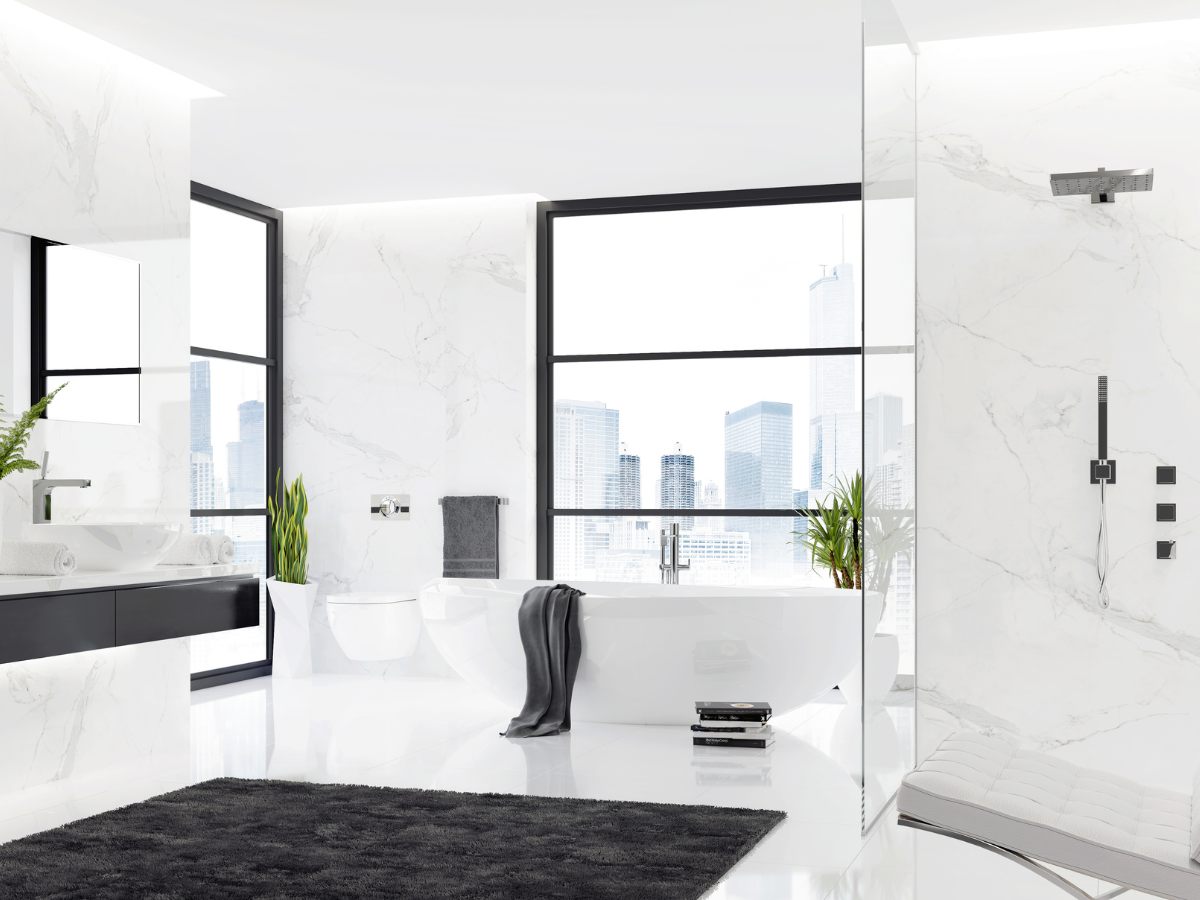
17. home remodeling – Practical focus
In practical terms, homeowners are advised to:
- Review and follow the Decision Rules noted above and also review the analysis noted in Section 14 of this Article.
- Consider not just the immediate financial implications, but also the longer-term enjoyment value of their remodel, but balance them wisely.
- Make remodel choices that result in the smallest %Bathroom Remodel Cost that yields the highest market returns considering the RR and HMIR (ROI).
- Time consideration is one of the elements which most decisively differentiates the behavior of the property investor versus the homeowner so act accordingly.
- Consider the impact of time as a planned consideration not as a justifier of bad investment decisions. Time plays a pivotal role in transforming potential financial losses and enjoyment value into recoverable value but only if the enjoyment value can be capitalized.
- The longer a homeowner enjoys the benefits of the remodel, the more the initial financial loss is offset by the increased quality of life the upgraded space provides over time. But using time as your investment adjuster from the start is synonymous to bad decision making.
- Stay informed about current trends and market standards to ensure your remodel decisions aligns with broad buyer appeal, enhancing the likelihood of recouping your investment.
- Try not to follow fading trends.
- In a remodel every body involve is responsible for reducing cost. However, not every one has an incentive to do so. Even the home owner chooses to maximize enjoyment at the expense of economic efficiency.
- Homeowners are encouraged to weigh the financial and tangible benefits of a bathroom remodel, against the personal satisfaction and lifestyle enhancements, such that “Time” will help rather than hinder the tangible financial viability and recoverability in case of resale.
18. Investment Properties
The treatment and analysis provided above is centered on occupied residences where the intent is to remain over the long term. Investment properties are a slightly different analysis. Refer to our Article titled – Bathroom Remodeling enhances Investment Property Values.

